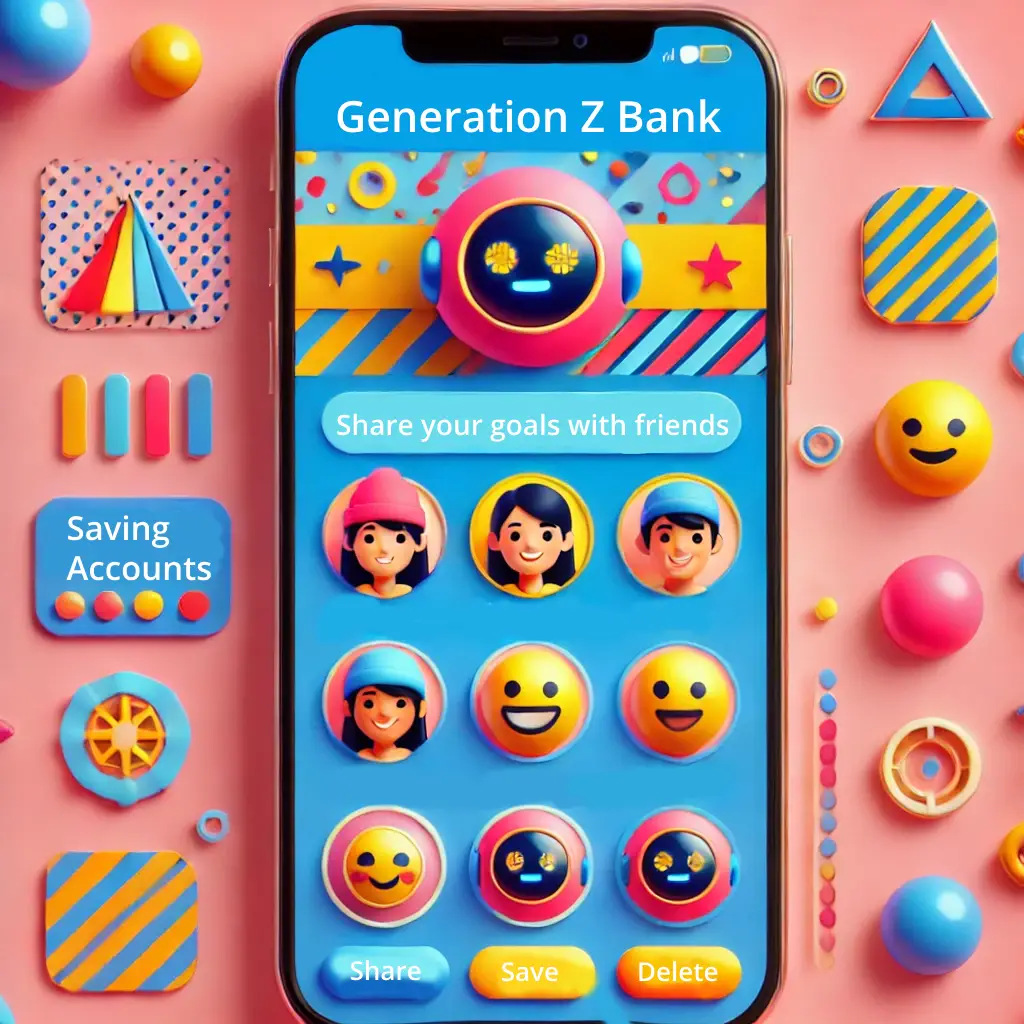Back to all Articles
Karol Andruszków
Karol is a serial entrepreneur who has successfully founded 4 startup companies. With over 11 years of experience in Banking, Financial, IT and eCommerce sector, Karol has provided expert advice to more than 500 companies across 15 countries, including Poland, the USA, the UK, and Portugal.
Gen Z Banking Expectations: A 2025 Overview
Updated:
Thu, Apr 17
Reading time: 11 minutes

Generation Z has become a defining force in the banking industry. With their spending power projected to exceed billions globally, they are not future customers. They are reshaping financial services today.
Unlike previous generations, Gen Z approaches banking with clear priorities. Below we describe these priorities nd how banks can address them.
For banks and financial institutions, this is both a challenge and an opportunity. Gen Z’s demands push traditional systems to innovate. Addressing these expectations can secure their loyalty during a critical phase of their financial lives. From saving for their first home to navigating student loans, this generation requires tailored solutions that simplify complex processes.
In this guide, we’ll dive into the specific expectations Gen Z holds for banks in 2025, and what financial institutions must do to stay ahead in the competitive market.
Unlike previous generations, Gen Z approaches banking with clear priorities. Below we describe these priorities nd how banks can address them.
For banks and financial institutions, this is both a challenge and an opportunity. Gen Z’s demands push traditional systems to innovate. Addressing these expectations can secure their loyalty during a critical phase of their financial lives. From saving for their first home to navigating student loans, this generation requires tailored solutions that simplify complex processes.
In this guide, we’ll dive into the specific expectations Gen Z holds for banks in 2025, and what financial institutions must do to stay ahead in the competitive market.
What are Gen Z’s Primary Financial Needs, and Pain Points?
Gen Z’s financial needs, pain points, and expectations can be summed up in three major themes: convenience, guidance, and values.
Convenience: “I want it as easy as streaming a movie.”
Gen Z wants banking to feel as effortless as browsing Netflix or Spotify. They grew up in a world where everything—from grocery deliveries to binge-watching a new series—happens instantly on their phones. They naturally expect the same frictionless experience from financial services.
This generation prefers to handle most of their transactions at their fingertips. Gen Z believes banking should require only a few taps and minimal hassle. The easier it is to get started, the more likely they are to trust and remain loyal to a particular bank.
This generation prefers to handle most of their transactions at their fingertips. Gen Z believes banking should require only a few taps and minimal hassle. The easier it is to get started, the more likely they are to trust and remain loyal to a particular bank.
Guidance: “Teach me how to drive, don’t just give me the car keys.”
Many Gen Zers are stepping into the world of personal finance for the first time. They are trying to figure out everything from budgeting basics to the nuances of credit scores. They don’t just want a bank to hand them a credit card or an app; they want someone to walk them through the “how” and “why” of managing money.
The fact is that financial literacy remains a big challenge. Services that simplify concepts through quick tutorials, infographics, or even gamified lessons, like a Duolingo for personal finance, tend to resonate.
Gen Z users seek a bank that offers personalized guidance, clear tutorials, infographics, and engaging features. Something that makes financial management less daunting and more accessible.
The fact is that financial literacy remains a big challenge. Services that simplify concepts through quick tutorials, infographics, or even gamified lessons, like a Duolingo for personal finance, tend to resonate.
Gen Z users seek a bank that offers personalized guidance, clear tutorials, infographics, and engaging features. Something that makes financial management less daunting and more accessible.
Values: “Walk the talk on social and environmental issues.”
Social media, climate awareness, and social justice shape Gen Z. As a result, they expect banks to embody ethical values, choosing those that reflect their beliefs and avoid "greenwashing.
It’s a bit like choosing a local café that claims to use fair-trade coffee—if they talk the talk, they’d better show the certifications to back it up. In the same way, Gen Z wants banks to prove they’re taking real steps to support the environment and social causes. Not just sprinkling their marketing with feel-good buzzwords.
It’s a bit like choosing a local café that claims to use fair-trade coffee—if they talk the talk, they’d better show the certifications to back it up. In the same way, Gen Z wants banks to prove they’re taking real steps to support the environment and social causes. Not just sprinkling their marketing with feel-good buzzwords.
Key Insights into Gen Z Spending Habits
In 2025, wellness is a key trend among teens, with spending on mental health apps, skincare routines, and online wellness communities. (source)
Despite budget concerns, quality remains crucial for Gen Z, with many preferring fewer high-quality items over numerous lower-quality ones. (source)
About 58% of Gen Z have purchased something they saw on social media, highlighting the platform's impact on their buying decisions. (source)
Despite comprising 24.6% of the global population, Gen Z accounts for 17.1% of total global spending. (source)
Over half (55.1%) of Gen Z consumers have utilized BNPL services, reflecting a preference for flexible payment options. (source)
Around 68% of Gen Z are eco-friendly shoppers, preferring to buy from brands that demonstrate environmental responsibility. (source)
More than 60% of Gen Z look for secondhand options before buying new items, indicating a shift towards sustainable consumption. (source)
Nearly 50% of Gen Z compare prices on Amazon before making a purchase, showcasing their value-conscious nature. (source)
Nearly half (46%) of Gen Zers rely on financial assistance from their parents to manage living costs, reflecting economic pressures. (source)
Approximately 97% of Gen Z consumers rely on social media for shopping inspiration, with user-generated content significantly impacting their purchasing decisions. (source)
How Banks Can Address Gen Z's Financial Habits
1. Gen Z Relies on Mobile and Social Media for Financial Decisions
With 53% of Gen Z already using "buy" buttons on social media, their reliance on digital tools for financial decisions is clear. Mobile and online platforms have become the part of everyday life for this generation.
Advice for Banks:
Build an intuitive, mobile-first banking ecosystem that integrates seamlessly with their lifestyle. Ensure access to human advisors when needed. A chatbot alone won’t suffice - Gen Z values hybrid support.
Example Tactics:
Advice for Banks:
Build an intuitive, mobile-first banking ecosystem that integrates seamlessly with their lifestyle. Ensure access to human advisors when needed. A chatbot alone won’t suffice - Gen Z values hybrid support.
Example Tactics:
- Develop gamified financial literacy apps. Help them learn about saving, investing, and credit management.
- Launch a "financial wellness assistant". Offer personalized insights and seamless access to human advisors for complex questions.
2. Authenticity Drives Loyalty
Authenticity and purpose are among Gen Z's most important values. They care about issues like sustainability and social responsibility. 77% of Gen Z are saying they won’t engage with brands that don’t meet environmental standards.
Advice for Banks:
Embed ESG (Environmental, Social, Governance) principles into your core identity. Transparency about the bank’s initiatives in sustainability and ethical finance will be critical.
Example Tactics:
You can find more inspiring ideas in our article: 8 Examples of Green Banking Initiatives That Stand Out
Advice for Banks:
Embed ESG (Environmental, Social, Governance) principles into your core identity. Transparency about the bank’s initiatives in sustainability and ethical finance will be critical.
Example Tactics:
- Offer “Green Accounts” . Allocate a percentage of profits toward climate action or sustainability projects.
- Partner with ethical brands to offer Gen Z-exclusive perks i.e. discounts for sustainable purchases.
You can find more inspiring ideas in our article: 8 Examples of Green Banking Initiatives That Stand Out
3. Financial Products Tailored to Life Stages
Gen Z has various life stages From students and gig workers to first-time home buyers. This diversity means a "one-size-fits-all" approach won’t work.
Advice for Banks:
Develop modular financial products that adapt to their evolving needs, emphasizing flexibility, education, and short-term financial solutions.
Example Tactics:
Advice for Banks:
Develop modular financial products that adapt to their evolving needs, emphasizing flexibility, education, and short-term financial solutions.
Example Tactics:
- Launch products like "Rent-to-Own Home Savings Accounts" tailored to Gen Z's delayed homeownership aspirations.
- Offer dynamic credit products that reward responsible behavior. For example increasing credit limits for those who hit financial wellness goals.
4. Build a Sense of Community
Gen Z feels isolated and they prioritize belonging and self-esteem. They respond well to brands that foster engagement and connection.
Advice for Banks:
Create digital communities around financial education and shared values to build loyalty.
Example Tactics:
Advice for Banks:
Create digital communities around financial education and shared values to build loyalty.
Example Tactics:
- Provide online financial wellness challenges (e.g., “Save $1,000 in 6 Months”) with leaderboards and rewards. This can be a part of your loyalty program
- Use influencers or micro-communities to spread authentic stories of financial success.
5. Financial Wellness
Good health is a top priority for Gen Z and they value wellness as much as financial success.
Advice for Banks:
Position yourself as a partner in overall well-being, not just financial stability.
Example Tactics:
Advice for Banks:
Position yourself as a partner in overall well-being, not just financial stability.
Example Tactics:
- Offer wellness-linked financial products. For example lower interest rates for customers who meet health-related goals tracked through fitness apps.
- Partner with health brands to provide rewards for gym memberships, therapy apps, or wellness subscriptions.
6. Education Through Social Channels
Social media heavily influences Gen Z's choices and they value interactive, visually rich content.
Advice for Banks:
Embrace platforms like TikTok, Instagram, and YouTube to deliver engaging financial education content.
Example Tactics:
Advice for Banks:
Embrace platforms like TikTok, Instagram, and YouTube to deliver engaging financial education content.
Example Tactics:
- Create a series of TikTok videos titled “Money Tips in 60 Seconds,” featuring real-life scenarios.
- Partner with influencers to explain complex financial topics like mortgages or investing.
7. Encourage Ethical Spending
Gen Z struggles with the “say-do gap” claiming they prioritize sustainability but still buy fast fashion and tech gadgets.
Advice for Banks:
Use rewards programs to guide spending habits toward ethical choices.
Example Tactics:
Data source of Gen Z Spendings
Advice for Banks:
Use rewards programs to guide spending habits toward ethical choices.
Example Tactics:
- Provide cash-back bonuses or lower transaction fees for purchases from eco-friendly merchants.
- Create a “Sustainable Savings Match,” where the bank matches small savings amounts for ethical spending.
Data source of Gen Z Spendings
What Does Gen Z Expect from their Banks?
Generation Z is reshaping the way banks operate, bringing bold expectations to the forefront of financial services. As digital natives, they demand seamless, tech-driven experiences that integrate into their fast-paced lives. But their needs go beyond convenience.
This generation values support that’s both practical and forward-thinking. Here’s how banks can rise to the challenge.
This generation values support that’s both practical and forward-thinking. Here’s how banks can rise to the challenge.
Digital-First Becomes Default
Gen Z has never known a world without smartphones. In 2025, they’ll expect every financial interaction to be fast, user-friendly, and fully digital. No clunky workarounds or long onboarding forms allowed. The process should feel as smooth as scrolling through a social media feed. Whether it is opening an account, authenticating with biometrics, or completing a KYC check in seconds.
How can Banks improve user experience for Gen Z?
- Growing up in an era where answers are just a swipe away, Gen Z has zero patience for complex interfaces or lengthy sign-ups. A simple registration in few clicks and identification using real-time data will be the gold standard in 2025.
- For Gen Z, the boundaries between online and offline hardly exist. They want banking that keeps pace across phones, wearables, and even emerging spaces like AR/VR - meeting them wherever they are in the moment.
- Checking balances, paying bills, transferring funds are handled by chatbots and virtual assistants. But Gen Z still values human support on-demand. Especially when dealing with more intricate needs like resolving fraud or discussing complex financial products. The Visa research shows that Gen Z is more inclined than the general adult population to prefer an AI chat program over a live agent for routine banking tasks (e.g., checking balances, transferring funds, paying bills). The percentage still leaves room for those who want human support, especially with complex issues.
- Gen Z is most comfortable making payments within the apps they already use, from social media to rideshares. By 2025, banks that integrate “invisible” payments and embedded service widgets into these everyday digital touchpoints will come out on top. Whether it’s a digital wallet baked into a super app or one-click purchases on a favorite social platform, social commerce is bridging the gap between content and transactions.
How can Banks improve user experience for Gen Z?
- Growing up in an era where answers are just a swipe away, Gen Z has zero patience for complex interfaces or lengthy sign-ups. A simple registration in few clicks and identification using real-time data will be the gold standard in 2025.
- For Gen Z, the boundaries between online and offline hardly exist. They want banking that keeps pace across phones, wearables, and even emerging spaces like AR/VR - meeting them wherever they are in the moment.
- Checking balances, paying bills, transferring funds are handled by chatbots and virtual assistants. But Gen Z still values human support on-demand. Especially when dealing with more intricate needs like resolving fraud or discussing complex financial products. The Visa research shows that Gen Z is more inclined than the general adult population to prefer an AI chat program over a live agent for routine banking tasks (e.g., checking balances, transferring funds, paying bills). The percentage still leaves room for those who want human support, especially with complex issues.
- Gen Z is most comfortable making payments within the apps they already use, from social media to rideshares. By 2025, banks that integrate “invisible” payments and embedded service widgets into these everyday digital touchpoints will come out on top. Whether it’s a digital wallet baked into a super app or one-click purchases on a favorite social platform, social commerce is bridging the gap between content and transactions.
Hyper-Personalization
Gen Z has grown up in a world where algorithms anticipate their every move. Whether it’s the next track on a Spotify playlist or a must-binge Netflix series. By 2025, they’ll demand the same level of customization from banks, expecting recommendations and services that align perfectly with their spending habits, personal goals, and even social values.
Data becomes the engine driving these hyper-personalized banking experiences. Gen Z wants product offers (a new credit card or a micro-investment opportunity) that make sense for their financial situation.
They’ll also look for real-time nudges that coach better money decisions, such as alerts about overspending or notifications on ESG-friendly funds if they’ve shown an interest in sustainability.
Gen Z values having easy-to-use financial tools. Apps with fun features, like saving money for vacations or tuition, can make saving more enjoyable and help them build good habits. For investing, tools like robo-advisors and online platforms can create personalized investment plans based on their goals, risk levels, and values. This makes it simple for Gen Z to invest in causes they care about.
Read more: How to Build Generation Z Bank?
Data becomes the engine driving these hyper-personalized banking experiences. Gen Z wants product offers (a new credit card or a micro-investment opportunity) that make sense for their financial situation.
They’ll also look for real-time nudges that coach better money decisions, such as alerts about overspending or notifications on ESG-friendly funds if they’ve shown an interest in sustainability.
Gen Z values having easy-to-use financial tools. Apps with fun features, like saving money for vacations or tuition, can make saving more enjoyable and help them build good habits. For investing, tools like robo-advisors and online platforms can create personalized investment plans based on their goals, risk levels, and values. This makes it simple for Gen Z to invest in causes they care about.
Read more: How to Build Generation Z Bank?

Value-Driven Banking
Gen Z, a socially conscious generation, expects more from banks than just profit. They want to see ethical behavior in real-time. For example clear disclosure of lending practices, environmental impact, and community involvement. We wrote more about this in our previous article: How Banks Use Green Finance to Attract Gen Z and Millennials
Gen Z wants clear, accessible data on how banks gather funds and where they invest. They also expect “green” credit cards or accounts that offset carbon footprints or support environmental projects. By 2025, ethical banking won’t be a perk—it will be essential.
Gen Z’s push for fairness shapes their views on social and economic issues. They prefer banks that reduce barriers for underbanked communities or offer student-friendly accounts. They also look for real brand activism, which means public stands on diversity and climate change backed by tangible action.
Gen Z wants clear, accessible data on how banks gather funds and where they invest. They also expect “green” credit cards or accounts that offset carbon footprints or support environmental projects. By 2025, ethical banking won’t be a perk—it will be essential.
Gen Z’s push for fairness shapes their views on social and economic issues. They prefer banks that reduce barriers for underbanked communities or offer student-friendly accounts. They also look for real brand activism, which means public stands on diversity and climate change backed by tangible action.
Financial Planning Support
As Gen Z enters adulthood, financial planning becomes a top priority. Many are thinking about major milestones, such as saving for their first home, starting a family, or pursuing further education. In fact, recent studies show that home ownership is among the top financial concerns for this generation. Yet, navigating these big decisions can feel overwhelming without the right support.
This is where banks can step in to make a meaningful impact. Gen Z values tools and services that simplify financial planning and provide actionable insights. Features like goal-setting trackers, mortgage calculators, and real-time budgeting apps can help them stay on top of their finances.
Additionally, banks can offer workshops or webinars tailored to Gen Z's needs, such as first-time mortgage guides or investment basics. Personalized financial advice (whether through human advisors or AI-driven platforms) can empower this generation to make informed decisions.
By addressing their concerns, banks can build lasting trust and loyalty with Gen Z, positioning themselves as true partners in their financial journey.
This is where banks can step in to make a meaningful impact. Gen Z values tools and services that simplify financial planning and provide actionable insights. Features like goal-setting trackers, mortgage calculators, and real-time budgeting apps can help them stay on top of their finances.
Additionally, banks can offer workshops or webinars tailored to Gen Z's needs, such as first-time mortgage guides or investment basics. Personalized financial advice (whether through human advisors or AI-driven platforms) can empower this generation to make informed decisions.
By addressing their concerns, banks can build lasting trust and loyalty with Gen Z, positioning themselves as true partners in their financial journey.
Conclusion: Meeting Gen Z’s Expectations
As we enter 2025, it’s clear that Generation Z is reshaping the banking landscape with their unique demands. They want banks to act as partners in their financial journey, offering tools and support that empower them to achieve their goals.
For banks, meeting these expectations isn’t about staying relevant. It’s about building long-term loyalty and trust with a generation soon dominating the workforce and financial influence. Banks that listen, adapt, and deliver solutions aligned with Gen Z’s preferences will gain a competitive edge.
This is where Ulan Software can help. With a proven track record in developing customizable, future-ready banking solutions, Ulan Software offers tools and platforms designed to address the unique challenges of engaging with Gen Z.
For banks, meeting these expectations isn’t about staying relevant. It’s about building long-term loyalty and trust with a generation soon dominating the workforce and financial influence. Banks that listen, adapt, and deliver solutions aligned with Gen Z’s preferences will gain a competitive edge.
This is where Ulan Software can help. With a proven track record in developing customizable, future-ready banking solutions, Ulan Software offers tools and platforms designed to address the unique challenges of engaging with Gen Z.
Karol Andruszków
Karol is a serial entrepreneur who has successfully founded 4 startup companies. With over 11 years of experience in Banking, Financial, IT and eCommerce sector, Karol has provided expert advice to more than 500 companies across 15 countries, including Poland, the USA, the UK, and Portugal.
Table of Contents:
What are Gen Z’s primary financial needs, and pain points?
Key insights into Gen Z spendings habits
How banks can address Gen Z's financial habits
What does Gen Z expect from their banks?
Digital-first becomes default
Value-driven banking
Financial planning support
Conclusion: meeting Gen Z’s expectations
Recommended Articles
Thu, Nov 20
Top 15 UX Tips to Improve Conversion Rates in Travel Booking
Improve travel booking flow conversion with 15 proven UX tips. Learn how mobile design, pricing clarity, speed, and smart flows reduce friction and lift bookings.
Mon, Nov 17
What to Look for in Enterprise Booking Software?
Learn what to look for in enterprise booking software: key features, integrations, security, and data to guide your 2025 selection.
Thu, Nov 6
Best White-Label Booking Software in 2025
Discover the best white-label booking software in 2025 for travel, appointments, car rental and events, with pros, cons, pricing and real user reviews.


